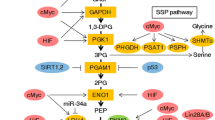Abstract
A proposed weak point in cancer cells is their need to synthesize novel or rare glucosphingolipids. It is further proposed that cancer patients be treated with a drug that slows the synthesis of glucosylceramide, the precursor of a large family of glucosphingolipids. Experimental data are furnished for chemotherapeutic and biochemical effects of PDMP, an analog of glucosylceramide and its precursor, ceramide. Promising results were obtained in the treatment of mice carrying Ehrlich ascites carcinoma cells and rats carrying C6 glioma cells. PDMP was found to be oxidized by cytochrome P-450, but this process could be blocked in vivo with piperonyl butoxide or cimetidine. A high level of blood glucose was found to elevate the size of rat kidneys and their content of UDP-glucose and its product, glucosylceramide. The excessive growth could be blocked by PDMP, which competes with UDP-glc for binding to glucosylceramide synthase. It is suggested that cancer patients be maintained at a low glucose level in order to slow the synthesis of glucosylceramide by tumor cells. Metabolic changes produced by PDMP in cultured cells, besides a rapid deletion of glucosphingolipids, were accumulation of the precursors (ceramide and sphingosine), loss of protein kinase C, and accumulation of diacylglycerol. It is suggested that many of the cellular changes produced by PDMP, such as loss of cell binding, are owing to existence of glucosylceramide-based “islands” floating in the outer cell surface; the islands may contain growth factor receptors and adhesion factors. An inhibitor that blocks sphingolipid synthesis, such as cycloserine, may prove to be a useful adjuvant for therapy with PDMP.
Similar content being viewed by others
References
Barbour S., Edidin M., Felding-Habermann B., Taylor-Norton J., Radin N. S., and Fenderson B. A. (1992).J. Cell. Physiol. 150, 610–619.
Byrne M. C., Farooq M., Sbaschnig-Agler M., Norton W. T., and Ledeen R. W. (1988).Brain Res. 461, 87–97.
Felding-Habermann B., Igarashi Y., Fenderson B. A., Park L. S., Radin N. S., Inokuchi J., Strassmann G., Handa K., and Hakomori S. (1990).Biochemistry 29, 6314–6322.
Fenderson B. A., Radin N., and Andrews P. W. (1993).Eur. Urol. 23 30–37.
Hakomori S. (1991).Cancer Cells 3, 461–470.
Holmes E. H., Hakomori S., and Ostrander G. K. (1987).J. Biol. Chem. 262, 15649–15658.
Hoon D. S. B., Kaback M. M., Lim-Steele J., Tsuchida T., Morton D. L., and Irie R. F. (1992).Biochem. Int. 27, 343–352.
Inokuchi J., Mason I., and Radin N. S. (1987).Cancer Lett. 38, 23–30.
Inokuchi J., Momosaki K., Shimeno H., Nagamatsu A., and Radin N. S. (1989)J. Cell. Physiol. 141, 573–583.
Inokuchi J. and Radin N. S. (1987).J. Lipid Res. 28, 565–571.
Kojima N. and Hakomori S. (1991).J. Biol. Chem. 266, 17552–17558.
Metz R. J. and Radin N. S. (1982).J. Biol. Chem. 257, 12901–12907.
Radin N. S., Brenkert A., Arora R. C., Sellinger O. Z., and Flangas A. L. (1972)Brain Res. 39, 163–169.
Radin N. S., and Inokuchi J. (1988).Biochem. Pharmacol. 37, 2879–2886.
Radin N. S., Shayman J. A., and Inokuchi J. (1993) Metabolic effects of inhibiting glucosylceramide synthesis with PDMP and other substances, inAdvances in Lipid Research; Sphingolipids in Signaling, Part B, vol. 26, (Bell R. M., Hannun Y. A., and Merrill A. H., eds.), pp. 183–213, Academic, San Diego.
Rosenwald A. G., Machamer C. E., and Pagano R. E. (1992).Biochemistry 31, 3581–3590.
Shayman J. A., Deshmukh G., Mahdiyoun S., Thomas T. P., Wu D., Barcelon F. S., and Radin N. S. (1991).J. Biol. Chem. 266, 22968–22974.
Shayman J. A., Mahdiyoun S., Deshmukh G., Barcelon F., Inokuchi J., and Radin N. S. (1990).J. Biol. Chem. 265, 12135–12138.
Shukla A. and Radin N. S. (1991).J. Lipid Res. 32, 713–722.
Shukla G., Shukla A., Inokuchi J., and Radin N. S. (1991).Biochim. Biophys. Acta 1083, 101–108.
Wachs H. (1947).Science 105, 530, 531.
Watkins P. B. (1990).Semin. Liver Dis. 10, 235–250.
Vunnam R. R. and Radin N. S. (1980).Chem. Phys. Lipids 26, 265–278.
Zador I. Z., Deshmukh G. D., Kunkel R., Johnson K., Radin N. S., and Shayman J. A. (1993).J. Clin. Invest. 91, 797–803.
Author information
Authors and Affiliations
Rights and permissions
About this article
Cite this article
Radin, N.S. Rationales for cancer chemotherapy with PDMP, a specific inhibitor of glucosylceramide synthase. Molecular and Chemical Neuropathology 21, 111–127 (1994). https://doi.org/10.1007/BF02815346
Received:
Accepted:
Published:
Issue Date:
DOI: https://doi.org/10.1007/BF02815346




